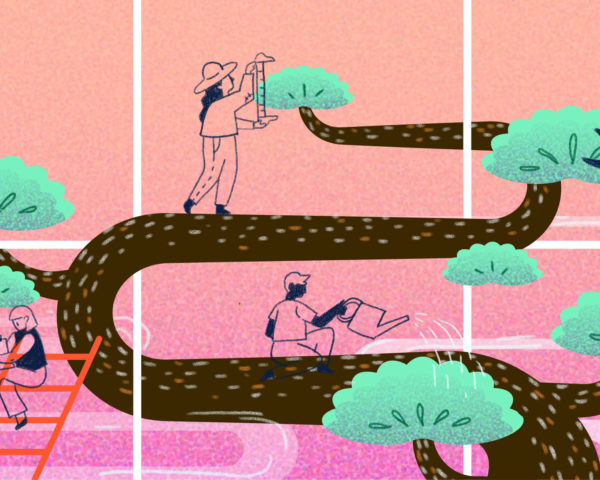This is what a successful home-grown innovation program looks like
We’re streamlining the journey from concept to customer – and so can you.
Jira Service Management wasn’t built in a day. But its predecessor was. Here’s the 30-second version of how it went down.
A small group of engineers and designers noticed how many fields Jira issues tend to have – help desk tickets for the IT team, in particular. They wanted to make issues appear simpler for some users, without losing the granular information other users might need. So when our quarterly 24-hour hackathon rolled around, they banged out an add-on for Jira and named it Viewport. Not only did Viewport win the grand prize that quarter, it grew up to be Jira Service Desk (now rebranded as Jira Service Management). The scrappy little hackathon project is now a multi-million dollar business.
As simple as JSM’s story sounds, the reality was anything but. There were a thousand points along the way where things could have gone off the rails, and looking back, it’s a minor miracle they didn’t.
Inventing products in-house is hard (but worth it)
Hundreds of companies have stories about “innovation labs” that are intended to crank out successes like JSM on repeat. Most also have stories about why their programs failed. Maybe the lab’s strategy wasn’t aligned with the rest of the business. Maybe it was staffed with the most skilled craftspersons instead of the most creative thinkers. And in any case, bringing an idea to life is one thing. Bringing it to market is a whole other story.
While growing your product portfolio through acquisitions is a proven strategy (one that Atlassian has employed several times), innovating from within is still a critical capability. Like a nation’s energy policy, you need to generate your own growth: market conditions may not allow other options, and investors take a dim view of companies that appear to lose their creative streak. Plus, a steady cadence of exciting new opportunities is key to retaining your most inventive employees.
The trick is to develop a repeatable process for taking new products from concept to customer, which is what Point A by Atlassian is all about. Incorporating lessons learned from other organizations, we set out to establish a program that gives teams the tools and resources needed to validate new ideas and bring them to market, with an eye towards rapid iteration and incremental investment. One year on, with 35 projects under our belts – four of which will soon be launching as new products – we believe it’s a model that companies in many different industries can learn from.
Guiding principles for a grassroots innovation program
To be a 50- or 100-year company, you have to invest in new products. As the core business matures, you need new revenue streams to stay viable and new career paths for your team. Outside your walls, customers’ needs are changing and the very nature of work itself is evolving. If you’re not building for the future, you’ll soon be a thing of the past.
With additional company-wide programs like ShipIt (our quarterly hackathon) and individual teams running ad-hoc “innovation weeks,” Atlassian has a stockpile of cool ideas and prototypes. The business of turning them into sellable products and getting them out the door was where we were struggling. “The point of Point A is to smooth the path in that last mile,” says Steve Goldsmith, Head of Product Management. So to streamline the process, we established three guiding principles.
- 100% home-grown – Product acquisitions and entrepreneur-in-residence programs both have their place. But this isn’t it.
- New products only – Features and add-ons are too small. This program is strictly for product ideas that are so big, they could be their own company.
- Be OK with failure – We expect half of the projects that make it through the exploration phase will fail somewhere in the development phase.
The emphasis on thinking big comes from a desire to rebalance our product portfolio. Before this program, our portfolio was composed of products we’re already selling, with the remaining 20 percent being products that were launching soon. That left a gap in terms of visionary products with a longer time horizon. Now we’re moving closer to a 70/20/10 ratio.
How the program works, phase by phase
Letting your most creative minds run wild, free from the constraints of red tape and “that’s how we’ve always done it” thinking, sounds great on the surface. But too little structure is a common reason why innovation labs and internal incubators fail. A successful program has guardrails that keep teams focused on specific business outcomes, and regular checkpoints to minimize the risk that resources are being wasted on an idea that isn’t viable.
Point A consists of several phases. In the first phase, someone with a good idea (and anybody in the company is eligible to be that “someone”) teams up with one to two interested people to explore a problem space and conceptualize a product that addresses it. They’ll also seek out an executive sponsor, who will stay with them throughout the process. As the team develops their concept, they ask themselves:
- Is this aligned with one of the company’s strategic priorities?
- Do we believe this could be a $100 million business in five to seven years?
- Where do we play and how do we win?
From there, they prepare to pitch their concept to Point A’s selection panel: our company founders (and co-CEOs), plus leaders from Product Management, Engineering, PR, Marketing, and Operations. In preparing their pitch, they think through a matrix of questions around product-market fit.

The panel assesses the pitch based on whether the problem is worth solving as well as similar considerations around product/market fit and strategic fit for the business. “Focusing on ideas that can have a massive impact doesn’t just tighten the selection criteria for Point A,” says Goldsmith. “It also helps us, as R&D leaders, parse which capabilities we should build in-house vs. what we could bring in through an acquisition.”
Within two weeks, the panel informs the project team whether they’ll be funded through the next phase, along with specific concerns they need to address.
The role of the sponsor
Executive sponsors meet with their project teams on a weekly basis to give actionable feedback on the product and guidance on advancing through the process. They also help prepare the team for checkpoints with the selection panel by sparring on the presentation and vetting the product decisions they’ve made so far.
For the development phase, the team gets an initial allocation of three to six members, whose roles are backfilled using contractors or our internal mobility program. For one of the Point A teams, early members were hand-picked by the project’s lead, while others were attracted by internal advertisements. “I was originally interested in a transfer to the Jira team,” recalls Andrew Freedman, the team’s product manager. “But [a VP of engineering] thought I’d be a better fit here. So credit to him for spotting people with the right blend of skills at the right stage.”
Teams then spend three months working with customers and building prototypes to prove their idea is viable. During this time, they meet with their executive sponsor regularly and course-correct based on their feedback. At the end of the three months, they present their prototype to the same selection panel. Passing this milestone means they’re a “go” for expanding the team and building the product for real, typically with a goal of launching in six months.
At that point, customers have a chance to be part of Point A by participating in the product’s beta program. Along with early access to the product, they have the opportunity to give feedback to product managers to help them fine-tune as they prepare for a general availability release.
There are no failures, only opportunities to learn
As of now, a total of 35 projects have come through the Point A program, of which nine were funded. Team Central and Jira Work Management are already in the hands of customers, thanks to their beta programs, with two other Point A products eyeing beta later this year. But even when an idea advances to the final phases, Freedman describes feeling like things could go sideways at any moment as “the default position.”
“Because you’re operating in such an uncertain environment,” he explains, “your frame of what success means and what the launch should look like is constantly changing.” The original idea he was working on was intended to be an add-on for Jira before it entered the Point A program. But as the project took shape, the team realized they actually had a stand-alone product on their hands. “That adds six to twelve months of work we hadn’t accounted for.”
Meanwhile, competitors were entering the market and gaining traction. “And you wonder how far they’ll have run in a year while we’re still putting our shoes on,” Freedman recalls. “The confirmation that your idea is something people will pay money for is really affirming, but it’s also alarming when you’re the one who’ll have to catch up.”
Sometimes the competition even comes from within. Steen Andersson, Head of Product Management for Atlassian’s teamwork platform and one of Point A’s first participants, saw this first-hand. Unbeknownst to him, Trello was developing its new list view feature, which allows users to see their Trello cards in a way that mimics a spreadsheet.
“We were pitching a new product that was basically the same as that,” he remembers. “We were all disappointed, but nobody was too fussed about it. We were one of the earliest teams to go through the process, so we got to validate that it works and that in itself was a success.”
Innovation that includes everyone
Despite the program’s similarities, both to innovation labs and startup incubators like Y Combinator, Goldsmith is adamant about breaking away from those models. “The easy way to do this,” he says, “is to create sort of a ‘Department of Innovation’ where you have a single leader, and you put a bunch of people in there and tell them to go create some new stuff.”
The trouble with that is two-fold. First, it absolves the rest of the company from having to think about it and may even dissuade people from outside the sanctioned innovation team from bringing their ideas forward. That’s why Point A was designed to be a discovery process – a megaphone for delivering novel solutions to customers.
Second, dedicated labs or teams don’t scale. According to Goldsmith, the real art is in “enabling scalable, distributed innovation that can match or beat the pace of the rest of the company’s growth.” In that sense, the program itself is an innovation.
“To me, that’s the most exciting part”, he says. “Finding a way for everyone in the company to be a part of product innovation is harder, but better in the long run.”












































